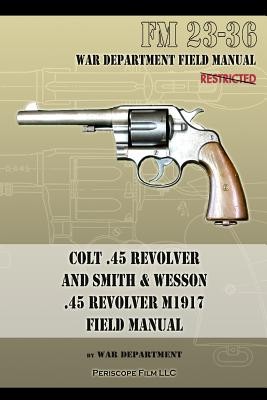
- We will send in 10–14 business days.
- Author: War Department
- Publisher: Periscope Film LLC
- ISBN-10: 1940453194
- ISBN-13: 9781940453194
- Format: 15.2 x 22.9 x 0.6 cm, minkšti viršeliai
- Language: English
- SAVE -10% with code: EXTRA
Colt .45 Revolver and Smith & Wesson .45 Revolver M1917 Field Manual (e-book) (used book) | bookbook.eu
Reviews
Description
The M1917 Revolver, formally United States Revolver, Caliber .45, M1917, was a U.S. six-shot revolver of .45 ACP caliber. It was adopted by the U.S. Army in 1917 to supplement the standard M1911 .45 ACP semi-automatic pistol during World War I. After, it was primarily used by secondary and non-deployed troops. There were two variations of the M1917, one from Colt and one from Smith & Wesson.The Colt M1917 Revolver was essentially the same as the M1909 with a cylinder bored to take the .45 ACP cartridge and the half-moon clips to hold the rimless cartridges in position. In early Colt production revolvers, attempting to fire the .45 ACP without the half-moon clips was unreliable at best, as the cartridge could slip forward into the cylinder and away from the firing pin. Later production Colt M1917 revolvers had headspacing machined into the cylinder chambers, just as the Smith & Wesson M1917 revolvers had from the start. The Smith & Wesson Model 1917 was essentially an adaptation of that company's Second Model .44 Hand Ejector, chambered instead for .45 ACP, employing a shortened cylinder allowing for use of half-moon clips, and a lanyard ring on the butt of the frame. After the First World War, M1917s became popular on the civilian and police market.Created in 1941, this field manual reveals a great deal about the M1917'sdesign and capabilities. Intended as a manual for those charged with operationand maintenance, it details many aspects of the gun assembly, accessories andtarget exercises. Originally labeled restricted, this manual was declassified long ago and is here reprinted in book form. Care has been taken to preserve the integrity of the text.
- Author: War Department
- Publisher: Periscope Film LLC
- ISBN-10: 1940453194
- ISBN-13: 9781940453194
- Format: 15.2 x 22.9 x 0.6 cm, minkšti viršeliai
- Language: English English
The M1917 Revolver, formally United States Revolver, Caliber .45, M1917, was a U.S. six-shot revolver of .45 ACP caliber. It was adopted by the U.S. Army in 1917 to supplement the standard M1911 .45 ACP semi-automatic pistol during World War I. After, it was primarily used by secondary and non-deployed troops. There were two variations of the M1917, one from Colt and one from Smith & Wesson.The Colt M1917 Revolver was essentially the same as the M1909 with a cylinder bored to take the .45 ACP cartridge and the half-moon clips to hold the rimless cartridges in position. In early Colt production revolvers, attempting to fire the .45 ACP without the half-moon clips was unreliable at best, as the cartridge could slip forward into the cylinder and away from the firing pin. Later production Colt M1917 revolvers had headspacing machined into the cylinder chambers, just as the Smith & Wesson M1917 revolvers had from the start. The Smith & Wesson Model 1917 was essentially an adaptation of that company's Second Model .44 Hand Ejector, chambered instead for .45 ACP, employing a shortened cylinder allowing for use of half-moon clips, and a lanyard ring on the butt of the frame. After the First World War, M1917s became popular on the civilian and police market.Created in 1941, this field manual reveals a great deal about the M1917'sdesign and capabilities. Intended as a manual for those charged with operationand maintenance, it details many aspects of the gun assembly, accessories andtarget exercises. Originally labeled restricted, this manual was declassified long ago and is here reprinted in book form. Care has been taken to preserve the integrity of the text.


Reviews